Interested in learning more about the most ancient scale of all time? Well, you’ve found the right place! Anyone can build a pentatonic scale starting on any note. This scale has been around as long as music itself. We often don’t recognize it as such because the pentatonic scale is part of a regular scale. The only difference between a pentatonic and a major scale is the absence of some notes. All scales and modes have 7 notes or… 8 if you count the octave of the first note. The pentatonic scale only has five. Leave out the 4th and 7th note of any major scale and you have a pentatonic scale.
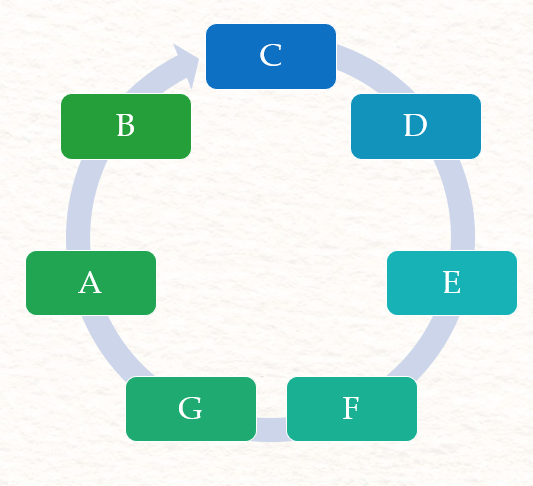
Figure 1
Figure 1 shows a “scale wheel” of notes. I put it in a circular format so you can see how playing scales isn’t linear – it’s circular. Clockwise is an ascending scale and counter clockwise is a descending scale. In this case, it’s a C Major scale which has no sharps or flats. Each note has a number: C = 1, D = 2, E = 3, F = 4, G = 5, A = 6, and B = 7. The 8th note is C, which is the octave of the lower C.
All scales use a formula, just like math has formulas to create a variety of equations. Major scales have half steps between notes 3 – 4 and 7 – 8. There are three forms of minor scales, and there are seven modes as well. Each type of scale places the half steps in different places.
If you’re not familiar with half and whole steps, here’s a quick tutorial. A scale of all half steps is called a chromatic scale. For example, start and C then C#, D, D#, E, F, F#, G, G#, A, A#, B, and that takes you back to where you started, only an octave higher to C. Basically, half steps cover all the white and black keys of a piano.
To create a whole step, SKIP a key. Let’s look at a piano keyboard (figure 2). You’ll notice that some white keys have no black keys between them. Those are half steps because there’s no key between them. A whole step MUST have ONE key between two notes. For example, C – D is a whole step because there’s a black key (D# or Eb) between the C and D. D – E is also a whole step but.. E – F is only a HALF step. Why? Because there’s no key between E – F. You’ll also notice that the black keys have two note names. We call those “enharmonic” because they sound the same but are written differently. The scale determines whether to sharp or flat a note. In music, we must spell scales correctly just like in any language. Words that sound the same often have different spellings (to, two, and too as an example).
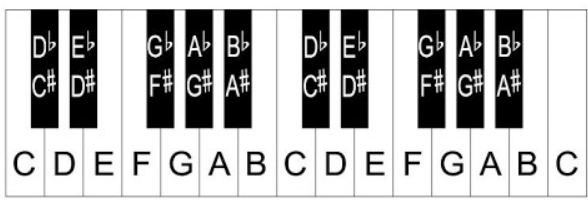
Figure 2
Let me say something here about the pentatonic scale before we begin building one. There is a misnomer out there that the scale was lost and not used until recently so that when we do use it, we’ve returned to ancient sounds. That’s absolutely not true. How do we know this? Most modern pop, rock, country, and even church music is based on the pentatonic scale. It’s the most natural scale known to mankind and simply flows off our lips. Why? Because it’s so prominent in the harmonic/overtone series and is pleasing to the ear. We’re so used to it that we don’t even recognize its daily use. Yes, we complicate it a bit but for those people with minimal musical experience, it’s by far the easiest scale to play! All the notes work well together. And, many chords within the chosen key also work well with the five notes of a pentatonic scale. So, it’s very much alive and in use today!
How to Build a Pentatonic Scale
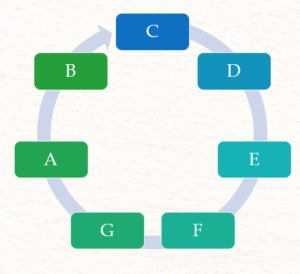
Figure 3
Look at the C Major scale wheel one more time (figure 3). I’ve put it here again so you don’t have to scroll back up to it. You’ll notice that there are seven notes. In order to create a pentatonic scale, all you need to do is leave out the 4th and 7th notes. In this case, those are notes F and B. Therefore, the C pentatonic scale is the following notes: C, D, E, G, A and then back to C.
There are people who talk about major and minor pentatonic. When starting on C, it’s a major pentatonic because your ear hears those first three notes as a major scale. To make it minor, simple take the final note (A) and begin with it. That scale then becomes A, C, D, E, G and then back to A. The distance between the A – C is THREE half steps (minor 3rd or m3). To your ear, it sounds minor because the interval (distance between notes) from the A – C has a minor sound to it.
Pentatonic scales have a formula, just like all other scales. That formula for a major pentatonic is: whole step (Major 2nd – written as M2), whole step, three half steps (minor 3rd – written as m3), whole step, whole step, and another minor 3rd (m3). Sometimes, you’ll see it written as: 2 – 2 – 3 – 2 – 2- 3. Those numbers refer to the intervals between each note of the scale.
Now, to create a minor pentatonic, take the last note (A) and make it the first note: A, C, D, E, G and back to A. Those intervals are now: 3 – 2 – 2 – 3 – 3 – 2 or… m3, M2, M2, m3, M2. So, to build a minor pentatonic, use the formula where the last note of the major pentatonic becomes the first note of the minor pentatonic
Here is what a the C Major and a minor pentatonic scale look like on the piano. (As an FYI, Major is capitalized and minor is small case). Both C Major and a minor use the same notes because they have the same key signature. In this case, no sharps or flats (figure 4).

Figure 4
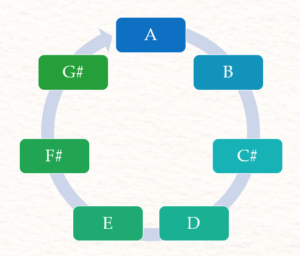
Figure 5
Let’s practice with another scale. This scale wheel starts on the note A (figure 5). It represents the key of A Major, which has three sharps (F#, C#, and G#). Take away the 4th and 7th notes (D and G#). The major pentatonic scale is: A, B, C#, E, F# and back to A. To build a minor pentatonic, start on the last note (F#) and build the scale from there: F#, A, B, C#, E and back to F#. It’s that simple!
NOTE: You can do this starting on any note! You may play a variety of chords with the scale, too. To help those who desire to do this, I’ve provided a chart below (figure 6) that includes all the possible pentatonic scales and most common chords that can be used with them. If you like to mess around on the piano, play ALL the black notes. They create a pentatonic scale! The messy part is when you have to play chords on the black notes.
Below is a chart (figure 6) with ALL pentatonic scales that start on every note of the keyboard. I’ve also included the three main chords that will sound good with that particular scale. To play the scale as a Major pentatonic, start on the first note and make Chord 1 your main chord. If you want to play it as a minor pentatonic, start on the 5th note and make Chord 3 your main chord. All three chords will work nicely for each pentatonic scale. Do note that you can start on any note you wish. Play around with them and simply have some fun!
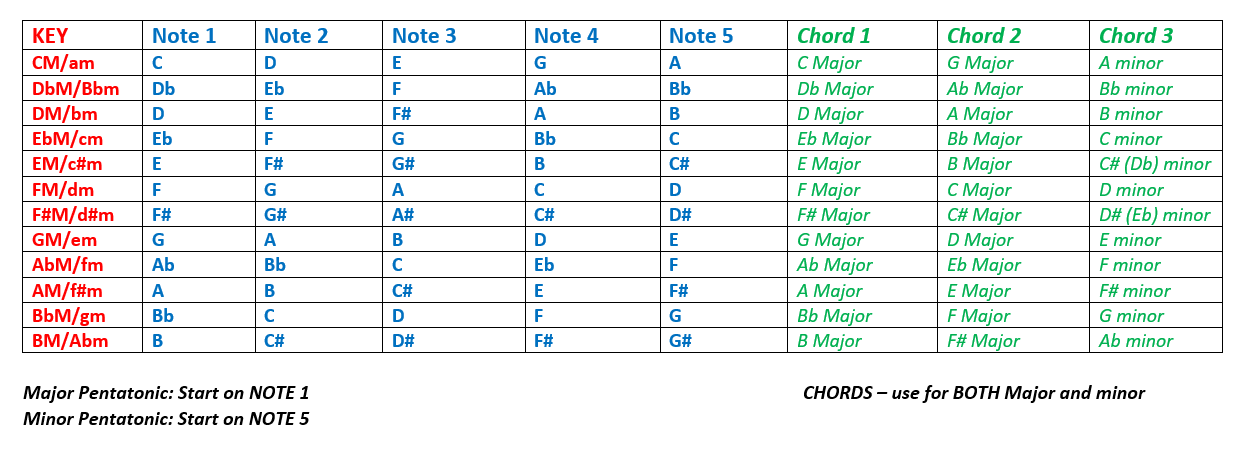
Figure 6
Parting Thoughts About Frequencies
There is a lot of incorrect information in internet land, including from many musicians about the use of specific frequencies especially in how they relate to scales. Musicians who don’t read music most often don’t understand the inner workings of music theory. Therefore, when it comes to describing the nitty gritty details of how frequencies work within scales, I’ve yet to see accurate information from someone other than a trained musician. I’m not trying to be a classical music snob here. I’m simply stating facts.
That all being said, our standard method of tuning is what we call “equal temperament.” That simply means the distance between notes is exactly the same. When you adjust the temperament, specific frequencies will vary slightly. Until the mid 1880’s (the start of the industrial revolution), there was no way to accurately measure the distance between notes. “Tempering” involves making adjustments in the intervals (distance between notes). For every composer and performer, that was different prior to measuring devices that did it for us. How an instrument was tuned was totally based on the preference of the performer/composer. Concert pitch is not the same as temperament. Concert pitch sets the overall tuning of an instrument. Temperament adjusts the distance between notes. Some performers like more dissonance and will purposefully tune intervals to create tension. Certain keys in the Baroque era were used BECAUSE composers wanted a specific type of dissonance which created a whole new tone color. Everyone had a personal preference. There was no standard. Equal temperament isn’t bad! What it does is allow modern instruments to play in all 24 keys without having to stop and re-tune to play in the nasty sharp and flat keys.
This leads to the next comment… many people come up asking me how to get specific frequencies they hear someone talk about or see proposed as being better than other frequencies. If you’ve read my article on Musical Intent, you’ll understand that our thoughts, intents, and actions make a HUGE difference in how frequencies affect us! No two people are alike. What works for one won’t necessarily be the best for someone else. We each have emotional baggage that filters into our body which then leads to various physical issues. I can’t say that a specific frequency will fix a problem. You need to test out the sounds that work for YOU! That may be different than what works for me. Now, I do put my intent into all my recordings. People respond to that because intent is part of my musical “recipe.”
For crystal bowls, they have quartz crystal in them, which is also present in your body. That’s one reason people tend to have strong reactions to the sounds of crystal bowls. They literally resonate with the water in your body! You’ll choose bowls based on what your body needs. What works for someone else may not be what you need! Allow your entire being to choose for you. If you don’t know what to order, listen to samples of crystal bowls, try them out at events, or order a full set. One day you might like one and another day, a different bowl will feel right. Be careful not to set absolutes when it comes to desiring specific frequencies. Why? Because intent is as much part of the recipe as the actual sound. Put your own intent into the crystal bowl for a desired result. Yes, there are some frequencies (outside of our hearing range) that have proven to be healing. You can choose music/sounds that resonate with your being to help bring you into wholeness – spirit, soul, and body.
Finally, here is a video of the pentatonic scale I put up on the Healing Frequencies Music YouTube channel. It compliments this blog post nicely! Enjoy!
May you enjoy the journey!
Del
© 2020 Del Hungerford
[mailerlite_form form_id=2]

